Looking to the future of the workplace there are many factors that will change the way we work. One of the most important when it comes to technology is the display.
The visual aspect of our computer set-up dictates how we view and engage in our daily tasks. It allows better communication, enables us to visualise our work and lets us see the results.
The basic aspects of the monitor hasn’t changed much since the first PCs were used in the office. We still have a screen which presents us with information. Of course, we’ve come a long way since then, resolution and colour capabilities have considerably increased, screens have got much, much thinner but we still use the same basic concept.
But could that change?
When developing our next-generation Monitor Arm, Arc, we researched what the future might hold for workplace displays. We’ve created a list of the new workplace display technologies we’re likely to (and hope to) see from next year to 20+ years in the future.
Present & almost here
1. Larger, Lighter Monitors & Borderless Edges
The main shift happening right now with office monitors is that many companies are replacing their old screens with larger agile flat screens. 32-inch+ screens are now common to see on a desk.
Monitors with ultra-thin borders (such as those from Eizo, pictured) that create futuristic looking workspaces is another trend currently emerging.
Meanwhile, the number of people using a dual screen setup is on the rise. Borderless monitors are allowing these people to get the most from this setup and improve their productivity as they can now create a larger seamless display between two screens.
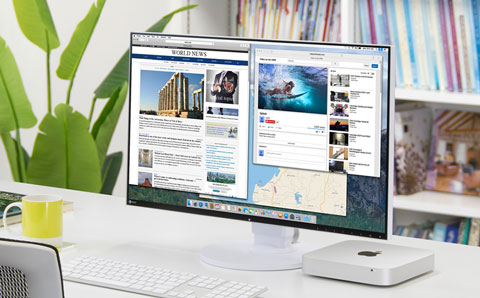
2. Curved Screens
Curved screens first became popular in the television market, however curved displays are better suited to a single viewer, with the centre being the only position to benefit from the viewing angle. Therefore, curved screens actually make more sense for office use.
Curved screens usually feature an ultra-wide display meaning that additional screens could become unnecessary, with the display dividing into windows to simulate individual screens.
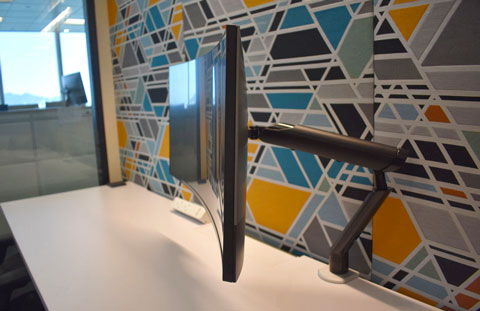
3. All-in-One PC & Monitors
All-in-one PC and screen displays are widely available and have been for some time. However, while the iMac is used in some offices, all-in-ones are rare to find in a workplace.
One reason for this is that all-in-ones can’t compete in specs, performance and often price with a traditional PC tower.
However, this is changing. The advances mentioned above mean that larger ultra-thin screens leave more space for the PC components, which are becoming smaller.
All-in-ones have also not gained popularity in the workplace as it is easier to replace just a screen or just a PC, but with fewer issues come fewer repairs. While easily separable components could make repairs and upgrades easier in future.
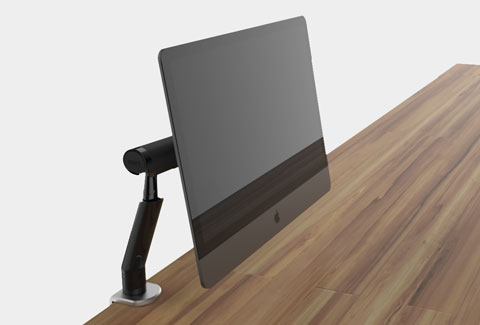
4. 4K Displays
4K ultra-high definition displays have roughly four times the amount of pixels as a typical HD screen, producing a noticeably higher quality of detail.
While 4K is becoming the standard for TVs, 4K resolution monitors are already available but aren’t common in workplaces as few see the benefit compared to current screens resolution.
The closer you sit to a screen the more benefits there are from a higher resolution, therefore 4K has many benefits on a desk. Richer colours and deeper blacks as well as a higher number of pixels will help reduce eye strain and fatigue.
As the workplace well-being trend continues to grow and prices reduce, companies will invest in 4K displays for their employees.
5. Touchscreens
We use touchscreens daily in our personal lives but they are yet to find their way to being used on a large scale within the office space. However, touchscreens have the potential to make input quicker and some tasks more user-friendly.
Beyond the basic touchscreen, screens that combine with a touchscreen work surface will make it easy to switch between the files you have on your desk and what’s on your screen. It would also provide a virtual keyboard.
Touchscreen work surfaces have already been brought to market, HP’s Sprout combines an all-in-one with a projection on to a ‘Touch Mat’ on the work surface. Sony’s Xperia Touch is another device bringing the projection touchscreen concept to life.
Whether this type of technology makes its way to office spaces is yet to be seen. There are some ergonomic and user experience issues if using this for long periods.
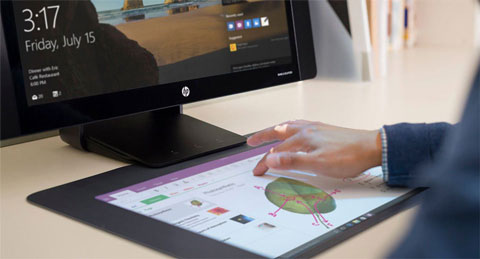
6. Gesture Control
Using hand movement and gestures to control what’s on your screen would take things a step further than touchscreens. Some technology companies, such as Asus have already begun including gesture control in their latest monitors.
It’s more ergonomic as, unlike with a touchscreen, there is no need to reach over a desk to a screen at eye-level or look down at a touchscreen at a hand-level.
Gestures can be designed that use more natural hand and wrist movements, than a keyboard and mouse or touchscreen input.
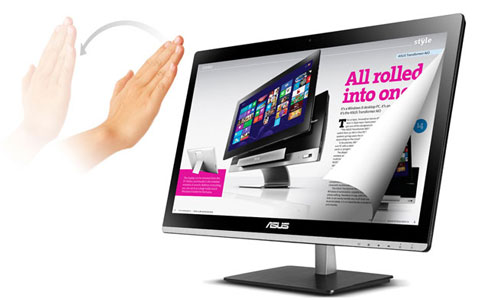
7. Virtual & Augmented Reality
Virtual reality and augmented reality have come a long way recently and growth is expected to continue as products such as the Facebook-owned Oculus Rift becomes widely available.
The virtual reality and augmented reality market have developed exponentially in recent years and this growth is expected to continue as more products make their way into the mainstream.
While the main professional use for virtual reality will initially be in design roles and won’t be replacing our desktop monitors anytime soon, concepts have been created to show how products such as Oculus Rift might work for traditional desk-based roles.
Microsoft’s HoloLens is another product which could revolutionise the way we work, allowing users to view, move around and interact with 3D displays. Concepts have been developed showing how this could be used in more traditional offices, one concept has demonstrated how it could help on a trading floor.
Near future (3-10 years)
8. 8K Displays
While 4K is a big step up from HD, 8K will be will be a giant leap. 4K video has a resolution of 8 megapixels per frame, 8K has 32 megapixels per frame. This will allow for even larger screens without any pixelation.
Adoption will be slow at first as 4K will be more than sufficient for most office-based roles but eventually like HD is now, 8K will become a standard.
9. Transparent Displays
Transparent screens have been a feature at the CES (Consumer Electronics Show) for a few years now but are yet to find their way to market, when they do it’ll initially be for televisions and advertising purposes.
However, the ability to display graphics on a clear screen means that almost any window, glass table or surface can be transformed into a display, particularly ideal for meeting and conference rooms. The information on the screens would not be visible from the other side so there would be no need for security concerns.
10. Wireless Connections
The first stage of wireless connection will see laptops and screens with wireless charging capabilities. After this, displays will also support cable-free connection to our other devices. For example, placing your laptop on the desk will immediately connect to the screen without needing to plug in any cables.
Wireless charging will one day be as simple for screens as it is with a phone. First concepts will need the back of the screen to make contact with a charging unit so there will be little change besides removing the need to plug it in.
However, the next charging evolution will charge devices through a connection similar to Wi-Fi. Apple has already patented a way to charge devices over Wi-Fi.
Combined with other future display technologies, such as flexible displays, wireless charging could perfect the ability to take your monitor with you anywhere.
11. Pocket PCs
The processing power and performance of our mobile phones will eventually be able to match what is capable of today’s high-end PCs. Rather than having a PC or laptop we could one day carry all we need in our pocket.
Combined with other technology advances, like those above, we can connect seamlessly to a display at a desk.
Currently available devices such as the Samsung DeX already allow you to place your mobile into a dock and essentially turn your phone into a desktop set-up.
12. Flexible & Foldable Displays
Curved screens are beneficial but flexible displays would mean a user could adjust the curve to suit their preferred eye line and position relative to the screen.
Foldable displays would provide more flexibility in where you work. A thin display that can be rolled or folded up would mean it could be taken anywhere with ease.
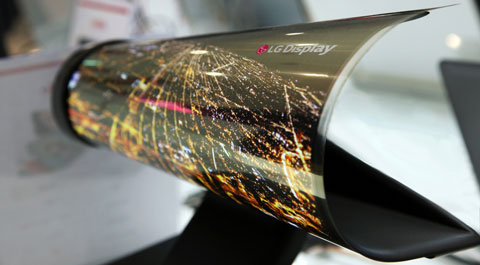
13. Eye Tracking
Having to use a keyboard or mouse could become a thing of the past altogether. While voice input is becoming popular, it simply won’t work for the vast majority of workplaces as noise is already a major distraction for many. Some voice commands also take longer than simply pressing a button or two.
Eye tracking and facial gestures could be the answer instead of voice input. This technology is already a reality. EYECAN+, Samsung’s eye mouse, allows people with disabilities to compose and edit documents as well as browse the web through simple eye movement.
14. Artificial Intelligence
While A.I. is likely to replace certain job roles, it will initially provide most people with an opportunity to focus their time on more important tasks.
A.I will be able to monitor what is on your screen and suggest improvements to your work, estimate time for completion and operate as a personal assistant by fetching files as you need them, booking meetings and sending messages on your behalf.
A continuous sync between A.I. across the workspace will enable greater collaboration on team projects. A.I. Assistants will automatically communicate and inform people about the progress of current projects.
Far future (10-20 years)
15. Holographic Displays
As mentioned earlier, HoloLens is making hologram-like display a reality but a pair of glasses are needed to see the images. Holograms would project a 4D display which can be seen by everyone.
The technology is already becoming a reality but it will be some time before we see it in the office. In 2018, RED is aiming to release a phone that features a holographic display alongside its traditional screen. However, low resolution is expected and how useful the display will be remains to be seen.
Holographics would allow better explanation for presentations and product demonstrations from anywhere in the world. Virtual representations could show how a product would look in the space they’re intended for.
Instead of attending physical meetings, workers could receive their brief from a holographic colleague, or send holographic messages to others without needing to be physically present.
16. Telepresence Systems
Holographics would give way to a system where someone working from home or in another office location could be working as if they were in the office. This would allow greater collaboration for those working remotely or in another office.
Effectively putting people in the same room allows better, more effective communication. Concepts using Microsoft HoloLens has already developed a basic concept but future solutions would be more sophisticated
Many of these concepts could be combined to further improve the way we interact and use displays at work.
While the typical screen isn’t disappearing anytime soon, in the years ahead, what we expect from a workplace display will change.
We’re seeing new possibilities now that were once the thing of sci-fi films. Virtual reality, for example, is making its way into the mainstream, AV tech companies are showing off flexible screen prototypes, and everyone’s talking about artificial intelligence.
The far future could hold display technology we can’t even begin to imagine.
The possibilities of how we’ll work in future are exciting but for now, we need future-proof workspaces and tools that can adapt to the screens we’re using today and tomorrow.


